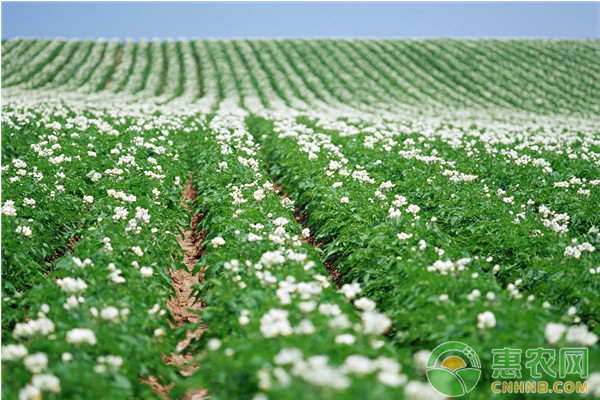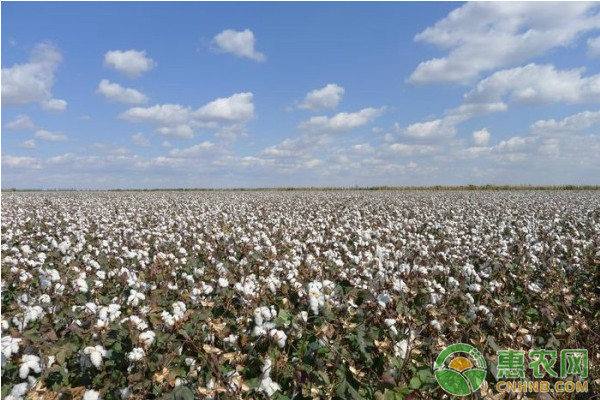Anhui Cotton-Potato Anniversary Cultivation Technical Regulations
Today, Huinong.com edited an article about Anhui cotton-potato simplification cultivation technical regulations from Anhui Agricultural Science. Farmers in need can learn more.

At present, cotton fields in Anhui Province are mainly composed of cotton and oil, supplemented by cotton and wheat, and the farming system is relatively simple. The contradiction between the two is more prominent, and the cotton field output rate, resource utilization rate, labor productivity and economic benefits are not high. In recent years, with the adjustment of agricultural industry structure and the promotion of potato mechanized production technology, the potato industry in Anhui Province has been accelerating its development year by year. The development of cotton-potato annual planting can not only increase the efficiency of cotton production to cotton fields, but also increase the income of cotton farmers, and effectively improve the comprehensive benefits of cotton fields, stabilize cotton production, and ensure food security.
Combining the climatic characteristics and ecological conditions of Anhui, the author explored, improved and improved the cotton-potato annual cultivation technology, and developed a light-simplified cultivation technique for cotton-potato in Anhui, in order to reform the cotton production mode and optimize the cotton planting system. Provide a basis for promoting the potato staple food process.
1 cotton-potato planting technology
1.1 cotton
The cotton was broadcast live in late May, and after the harvest in November, the cotton straw was mechanically crushed and returned to the field. The target lint yield is about 1500kg/hm2, and the flowering rate before frost is over 95%. Compared with conventional cotton cultivation, it saves 75~150/hm2.
1.2 potato
The potato was sown in the second year, the Huaibei cotton area was planted in mid-February, and the cotton planting area was planted from mid-January to early February. After the potato is harvested in the middle and late May, cotton can be sown. The target yield of potato fresh potato is about 30t/hm2.
2 cotton light simplification cultivation technology
2.1 Variety and density
The cotton varieties with compact plant type, smooth boll opening and medium-premature and early-maturing cotton with medium and early maturity are selected. The planting density of medium-early-maturing varieties is 67,500-90,000 plants/hm2, and the planting density of early-maturing varieties is 90,000 to 120,000 plants/hm2. The Huaibei cotton area should be planted with a line spacing of 66cm or 76cm, and the cotton area along the Yangtze River should be planted at a line spacing of 76cm or 81cm.
2.2 Sowing and fertilizing
Seeding was carried out using a no-till precision rotary seeding machine. When the cotton machinery is planted, the cotton-specific formula slow-release fertilizer is applied 1000~1200kg/hm2. From the end of July to the beginning of August, the pure seedlings can be applied with 75kg/hm2 of pure nitrogen and fertilized by the cultivating ditch machine. From mid-August to early September, if there is any sign of lack of fat or premature aging, spray 1.0% to 2.0% urea solution plus 0.3% to 0.5% potassium dihydrogen phosphate solution in combination with the control of the leaf surface. The amount of liquid is not less than 750 kg. / (hm2·times), spray once every 7~10d, even spray 3~4 times.
2.3 Chemical regulation
In the bud stage, early flowering stage, full flowering stage and topping stage of cotton, 5~7d, the chemical regulation is carried out by spraying ketamine at a ratio of 1:2:3:4, and the total amount of purified ketamine is 180~270g. /hm2. According to the condition of the seedlings and the weather conditions, the number and amount of spraying chemical regulators should be appropriately adjusted. When the early-maturing cotton variety or density is small, the amount of ketamine is the lower limit of the recommended dosage; when the medium-early-maturing cotton variety or density is larger, the amount of ketamine is the upper limit of the recommended dosage.

2.4 Pest Control
The diseases are mainly Fusarium wilt, Verticillium wilt, stem blight, and bell disease. The insect pests are mainly cotton bollworm, cotton blind mites, cotton aphid, beet armyworm, and Spodoptera litura. Machine defense, combined with biological pesticides and catching and trapping (frequency vibration), etc., but also need to use safe pesticides that are low in toxicity, easy to decompose and have no adverse effects on the potato.
2.5 full chemical weeding
Before seeding: Before the emergence of grasses, weeds can be sprayed with acetochlor or metolachlor; grasses mixed with broad weeds and broadleaf weeds, oxyfluorfen, etc. spray.
Before emergence, before buds: when grass weeds are dominant, weed spray can be applied to weed stems and leaves and soil with glyphosate + acetochlor or metolachlor; in grasses, broadleaf and sedge When the weeds are mixed, a herbicide having a broad spectrum of herbicides such as oxyfluorfen or a herbicide may be selected, or a mixture of two or more herbicides may be used, or a mixture such as oxyfluoride and acetochlor may be used.
After the bud: after the cotton buds, the plant height is more than 30cm and the stalks of the cotton plant turn red and hard, the weed stems and leaves are sprayed with glyphosate and paraquat.
2.6 pruning and topping
When the cotton plant density reaches the design density, the whole growth period of the cotton does not require pruning. When the number of fruit branches per plant is 10 to 12, the topping should be done, and the topping should not be later than the first month of August.
2.7 defoliation ripening
After spraying defoliant ripening agent 2Od, cotton defoliation rate of 90% up to 95% boll opening. Spraying conditions defoliants ripener natural cotton boll opening ratio of 40% to 60%, cotton boll 40d in the above upper bell; generally 18 ~ 25d before harvest spraying, and requires continuous 7 ~ 10d average temperature above 20 ℃, the minimum temperature of not less than 14 ℃. For late-maturing, growth potential wang, cotton autumn peach and more, it may be appropriate to postpone the spraying period and appropriate increase in dosage, whereas spraying in advance and can reduce the dosage. The reference dosage is thidiacarbone wettable powder 300~600g/hm2 plus 40% ethephon 1500~3000mL water 900kg/hm2.
3 Potato mechanized cultivation technology
3.1 species selection and seed treatment
Selection of early tuber, tuber enlargement fast, high yield, disease resistance early, mid-maturing varieties of potatoes, such as Favorita, Zhongshu 3, etc., field seed quantity is around 2250kg / hm2. Select the seed potato before cutting, remove the diseased potato, rotten potato, hybrid potato, and deformed potato; when cutting, each potato cake weighs 30~50g, at least 1 bud. Cut the cut potato pieces into neutral talcum powder to promote the healing of the knife edge. You can also use the medicine (50mL or Antaisheng 100g + Gaoqiao 20mL plus 100kg seed potato) for seed dressing, and put it indoors to dry to the face to heal. So plant again.
3.2 Soil preparation and fertilization
The mulch was used to cover the ridge cultivation mode, with a ridge height of 20 cm and a groove width of 30 cm. When the single ridge is cultivated in a single row, the ridge width is 60 cm; when the row is double, the ridge width is 80 cm. The base fertilizer is mainly composed of organic fertilizer and inorganic fertilizer, and the fertilization is completed during land preparation, ridge and sowing.
The application amount of basic fertilizer in potato is 80% of total fertilization, commercial fertilizer is 1500kg/hm2 or farmyard fertilizer is 45000kg/hm2, nitrogen, phosphorus and potassium ternary compound fertilizer is 900~1200kg/hm2, zinc sulfate is 18kg/hm2, boric acid is 15kg/ Hm2. Topdressing is mainly inorganic fertilizer, and the application rate accounts for 20% of the total amount of fertilization. Generally, urea is 22kg/hm2 and potassium sulfate is 240kg/hm2. During the expansion period of potato tubers, the mixture of 0.3% potassium dihydrogen phosphate and 0.05% borax was sprayed 3~4 times on the foliage to supplement the phosphorus, potassium and boron fertilizers to promote the expansion of the potato tubers.
3.3 sowing seedlings
It adopts mechanical sowing to complete ditching, fertilizing, sowing, covering soil, ridging and covering the film. The seeding density is about 67,500 plants/hm2, and the seeding depth is 8-10 cm. When the double line is small, the line spacing is 20cm, and the triangle is used for seeding; the single ridge is sown in the middle of the ridge. 3d before the emergence of the potato (the potato buds are about 1.5cm away from the ground), the mulch mulch is covered with 2cm thick soil by the cultivator, and the potato seedlings can rupture the mulch.
3.4 Field Management
In the 5~6 leaves of the potato and the expansion of the potato tubers, the soil was ploughed once to facilitate the expansion of the potato pieces and prevent the potato chips from being green. Pay attention to clean the trench and prevent the stains from draining. Watering in a timely manner during drought, the soil should be kept moist throughout the potato period, and watering should be stopped 10 days before harvest.
Potato diseases are mainly early blight, late blight, bacterial wilt and ring rot. The pests are mainly aphids, mites, whitefly, red spiders and so on. Refer to the NY/T 393-2013 Guidelines for the Use of Green Food Pesticides for the use of chemical pesticides. When the potato is mad, spray paclobutrazol (100~200mg/kg) to inhibit the growth of the shoots and promote the expansion of the underground tubers.
3.5 Harvest Grading
In the middle and late May, most of the stems and leaves of the potato turn from green to yellow, and the tubers are mature, which is the best harvest period. Considering the production and market prices, the market will be harvested as soon as possible. After the mechanical harvest, pick up in time, and moderately dry the surface moisture of the potato chips, according to 100g or more for the first grade, 50 ~ 100g for the secondary packaging.
4 Discussion
According to the cotton and potato cultivation habits, the cotton-potato simplification cultivation techniques are integrated into the more mature light-simplified and mechanized cultivation techniques, replacing the traditional wheat/oil-cotton two-cooked with cotton and potato, and using cotton mechanical precision. The live broadcast replaces the traditional nutrient seedling transplanting, replaces the common fertilizer with the cotton-specific formula slow-release fertilizer, replaces the manual operation with mechanical cultivating, replaces the natural maturity with defoliation, and replaces the traditional artificial cultivation with the mechanized cultivation of potato.
The procedure adopts light and simplified mechanized cultivation techniques in the stages of sowing, fertilization, cultivating and weeding, pest control and harvesting, which meets the agricultural development direction of saving cost, labor saving, high efficiency and environmental protection, and has certain support for cotton-potato standard production. Guidance role.
The Anhui cotton-potato light-simplified cultivation technical regulations are finished today. If your situation is similar to that of Anhui, you can learn more. More exciting agricultural technology Hui Nong.com has it all!
We're Professional Supplier Extract Powder manufacturers and suppliers in China specialized in providing high-quality products at low price. We warmly welcome you to buy or wholesale bulk Supplier Extract Powder for sale here from our factory. For a free sample, contact us now.
Supplier Extract Powder,Supplier Extract ,Supplier Powder Manufacturer in China
Shaanxi Kang New Pharmaceutical co., Ltd. , https://www.bodybuildingoil.com